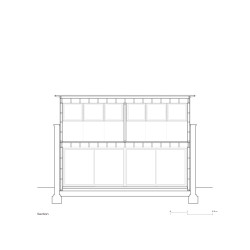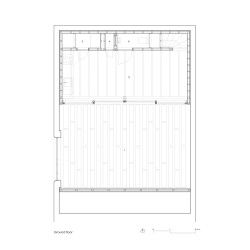Russell Jones . photo: © Rory Gardiner . + architecture today
Russell Jones has created a compact timber house within the perimeter wall of a Victorian outbuilding in north London.
A new two-bedroom house designed by architect Russell Jones, on Windsor Road in Tottenham, north London, is within a diverse residential neighbourhood made up of long terraced streets lined with two-storey Victorian and Edwardian houses. The 70-square-metre site is located behind what was a Victorian beer seller’s premises; the single-storey brick outbuilding was originally used to store beer barrels and for stabling. In later years it became an independent workshop.
The client, a small-scale private developer, purchased the site in June 2017. The brief called for an existing storage building and yard to be converted for residential use without compromising the adjacent property. Given local real-estate values and the small footprint, maximising the building envelope within a limited budget was critical. The project achieved planning permission in 2018 and was completed in April 2019.
The 60-square-metre house sits within the brick walls of the outbuilding. Using the existing foundations, the two-storey, timber-framed building rises above the retained brick envelope. The new form loosely follows the profile of its Victorian predecessor, while the choice of materials allow the existing building to remain both clearly legible and an integral part of the project.
The house is accessed directly from Windsor Road, via an existing cobbled entrance and retained black steel gates. The relationship between the yard and building has been maintained and the 40-square-metre exterior space now forms the entrance and private courtyard for the new house.
In following the footprint of the existing building, the house naturally orientates itself south towards the yard. At ground floor, full-width glazed sliding doors link and extend the open-plan living, dining and kitchen space to the private courtyard. The stairs, WC, storage and laundry are organised along the rear ground wall to maximise open-living space towards the south aspect.
On the first floor, two bedrooms and a bathroom share natural light from clerestory windows to the north. A continuous ribbon of fully openable windows along the south provides the bedrooms with natural light and ventilation, while angled timber louvres create privacy, preventing views into the new house from neighbouring properties.
There is a distinction between the new building and the existing brick structure, and a contrast between the expression of outside and in. The new external walls and roof are clad in corrugated cellulose sheets, dipped in bitumen. The matt-black exterior palette, corrugated sheets, thin roofline and simple detail nod to the site’s original heritage.
Internally, exposed structural pine sections used for the floor and roof structure run north-south towards the courtyard. All soffits, internal walls, cabinetry and doors were fabricated on site using sheets of birch ply. Hand-turned timber doorknobs introduce a level of delicacy within the straightforward construction. The white oil-washed ply surfaces create a gentle interior atmosphere in contrast to the exterior.
Text by Architecture Today
_





























